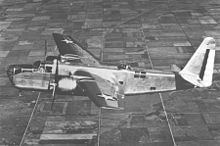Top speed 413 km/h Length 16 m | Wingspan 20 m First flight 1938 | |
 | ||
The Stearman Model X-100 was a competitor in a United States Army Air Corps competition for a twin-engined attack aircraft which (after redesigns) led to the Douglas A-20 Havoc, Martin A-22 Maryland and North American B-25 Mitchell.
Contents
Design and development
The X-100, designated XA-21 following purchase by the Army Air Corps, was a twin-engined high-winged monoplane of all-metal construction. It featured an unusual cockpit arrangement, much like those on most German World War II bombers designed during the war years, with a streamlined greenhouse canopy enclosing both the pilot and bombardier stations.
Operational history
The XA-21 was first tested with the streamlined cockpit but this configuration was found to restrict the pilot's forward vision, and the aircraft was rebuilt with a conventional (stepped) nose and cockpit structure. Although this change in the cockpit did not significantly affect performance, the XA-21 was not ordered into production.'
The sole XA-21 had serial number 40-191.
Operators
Specifications (XA-21)
Data from Museum of the United States Air Force
General characteristics
Performance
Armament
